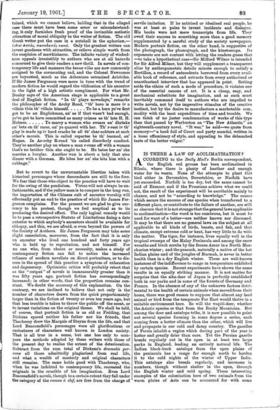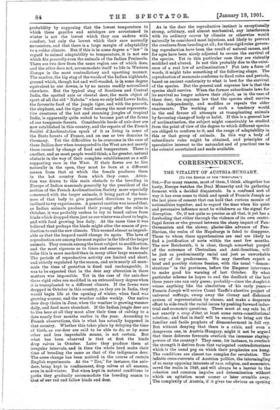IS THERE A LAW OF ACCLIMATISATION P
AsCCORDING to the Daily Mail's Berlin correspondent, the English red grouse has been acclimatised in Silesia, where there is plenty of heather and enough water for its wants. None of the attempts to plant this bird either in Devonshire, Dorsetshire, or Norfolk have yet succeeded. Norfolk is too dry, but the same cannot be said of Exmoor, and if the Prussians achieve what we could not, the result of the experiment will be ascribable mainly to chance, and not be "according to knowledge." The causes which secure the success of one species when transferred to a different place, or contribute to the failure of another, are still so obscure that it is not strange that the general laws applicable to acclimatisation—the word is too cumbrous, but it must be used for want of a better—are neither known nor discussed. It may be that there are no general laws on the subject at all applicable to all kinds of birds, beasts, and fish, and that climate, except extreme cold or heat, has very little to do with the matter. The tiger, for instance, lives equally well in the tropical swamps of the Malay Peninsula and among the snow wreaths and birch scrubs by the frozen Amur in a North Man- churian winter; and the peacock, naturally a native of the hot Indian plains and of the jungles of Burmah, is never in better health than in a dry English winter. These are well-known instances of the indifference to range in temperature exhibited by certain species. Recent experiments have shown the same results in an equally striking manner. It is not matter for surprise that the sika-deer of Japan is perfectly established both in our parks and in some of the forests of Germany and France. In the absence of any of the unknown factors detri- mental to the health of certain animals when moved from their home, there was good reason to suppose that almost any land animal or bird from the temperate Far East would thrive in a suitable environment here. So will the wapiti-deer, whether the Asiatic species or that from the Rocky Mountains. But among the deer and antelope tribe, it is now possible to point out several species forming in some degree a series, each coming from a hotter climate than the other, which will live and propagate in our cold and damp country. The gazelles of Persia inhabit a region which during part of the year is hotter and greatly drier than ours. Yet the Persian gazelle breeds regularly out in the open in at least two large parks in England, leading an entirely natural life. The Indian black-buck antelope from the open plains of the peninsula has a range far enough north to harden it to the cold nights of the winter of Upper India. This antelope also breeds regularly, and increases in numbers, though without shelter in the open, through the English winter and cold spring. These interesting examples of the colonisation here of two animals from the warm plains of Asia can be accounted for with some probability by supposing that the lowest temperature to which these gazelles and antelopes, are accustomed in winter is not the lowest which they can endure with comfort, but only the lowest which their race normally encounters, and that there is a large margin of adaptability to a colder climate. But if this is in some degree a " law " in regard to animal adaptability to temperature, it is not one which fits generally even the animals of the Indian Peninsula. There are two deer from the same region one of which does, and the other does not, accommodate itself to life in Western Europe in the most contradictory and upsetting mamaer. The sambur, the big stag of the woods of the Indian highlands, ground which, though hot and well-wooded, is in some degree equivalent to our downs, is by no means readily naturalised elsewhere. But the typical stag of Southern and Central India, the spotted axis or cheetal deer,. the main object of sport of all the old " Nabobs " when we only held Lower India, the favourite food of the jungle tiger, and with the peacock, the elephant, and the tiger itself among the most representa- tive creatures of the hot and steaming jungles of tropical India, is apparently quite suited to become part of the fauna of our temperate forests. Considerable herds of axis-deer are now established in this country, and the reports of the French Societe d'Acclimatation speak of it as living in some of the State forests of France, and on one or two domains in Germany. Yet the difficulties to be overcome in the vase of these Indian deer when transported to the West are not merely those caused by change of food and temperature. There is another, and as most people would think; a far greater, natural obstacle in the way of their complete establishment as a self- supporting race in the West. If their fawns are to live naturally in the open, they must be born at a different season from that at which the female produces them in the hot country from which they come. Atten- tion was drawn to this main obstacle to the breeding in Europe of Indian mammals generally by the president of the section of the French Acclimatisation Society more especially concerned with the larger animals, it being part of the busi- ness of that body to give practical directions to persons inclined to try experiments. A general caution was issued that, as Indian animals produced their young after the rains in October, it was probably useless to try to breed calves from hinds which dropped them just as our winter was about to begin, and with food growing less daily. At the same time it was believed that perhaps the hinds might alter the season of pro- duction to suit the new climate. This seemed almost as improb- able as that the leopard could change its spots. The laws of reproduction are among the most regular in the life of the larger animals. They remain among the least subject to modification, and the most rigorous as to times and seasons. In the deer tribe this is more marked than in many other large mammals. The periods of reproductive activity are limited and short, and strictly regulated by the season, and as in nearly all mam- mals the time of gestation is fixed and unchangeable, it was to be expected that in the deer any alteration in these matters was impossible. Yet in the case of the axis-deer these rigid rules are modified in an extraordinary degree when it is transplanted to a different climate. If the fawns were dropped in October in this country, as they are in India, they would begin life at the opening of winter, when food was growing scarcer, and the weather colder weekly. Our native deer drop theirs in June, when the weather is growing wanner daily, and food more abundant. If the Indian jungle deer are to live here at all they must alter their time of calving to a date nearly four months earlier in the year. According to French observations, this is what has actually happened in that country. Whether this takes place by delaying the time of birth, as roe-deer are said to be able to do, or by some other and less improbable means, is not certain. But what has been observed is that at first the hinds drop calves in October. Later they produce them at irregular intervals, and in time the whole herd make their time of breeding the same as that of the indigenous deer. The same change has been noticed in the course of certain English experiments. At the "Zoo," for instance, the axis- deer, being kept in confinement, drop calves at all seasons, even in mid-winter. But when kept in natural conditions in parks they gradually accommodate the breeding season to that of our red and fallow hinds and deer.
As in the deer the reproductive instinct is exceptionally strong, arbitrary, and almost mechanical, any interference with its ordinary course by. climate or otherwise would naturally be considered most injurious, and likely to prevent . the creatures from breeding at all; for these rigid rules govern-.. ing reproduction have been the result of natural causes, and for ages have been nicely adjuated to secure the survival of the species. Yet in this particular case they are .violently modified and altered. Is not this probably due to the exist- ence of a real law of acclimatisation? Put into a form of words, it might take something of the following shape. The reproduction of mammals conforms to fixed rules and periods, based on ancient conformity to what is best for the survival of the species. But the general and supreme law is that the species shall survive. When the former subordinate laws for - its survival no longer achieve their object, as in the case of these deer, the supreme law that the species shall survive works independently, and modifies or repeals the older. enactments. The working of such a tendency would. - in the end favour all attempts at transplanting animals by favouring change of body or habit. If this is a general law of acclimatisation, the subject might conceivably. be studied from the point of view of the degree to which different species are obliged to conform to it, and the range of adaptability - this or that group of animals. In this way a body _of subordinate rules might be obtained, and principles of speculative interest to the naturalist and of practical use to the colonist ascertained and made available.







































 Previous page
Previous page